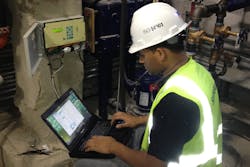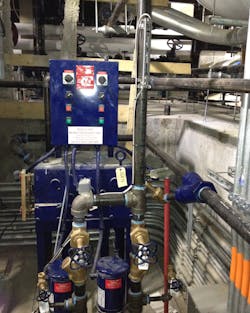New metering advances combined with the many variables of metering on the steam side of a heating system have energy managers opting to do their metering on the condensate side of their direct-energy boiler systems.
Steam-side metering problems
Traditionally in steam heating systems, metering is performed on the steam side. This is likely because that is how outside providers of steam have measured it over the years for their commercial customers. But metering on the steam side has serious difficulties.
First, there’s the environment — extremely high temperatures, compressibility and density changes because of pressure and load variances, and operating ranges that vary extremely depending on the time of year.
The second is the type of meter that is perceived as the most effective in this hostile environment — the vortex shedding meter — is not as effective at measuring steam as many energy managers believe. It works by inserting a blunt body called a shedder bar into the steam flow to create vortices as the steam passes around the bar. A sensor detects the vortices and the flow rate, which is proportional to the velocity.
The problem with vortex & DP meters
Unfortunately, vortex meters have one important flaw: They don’t measure low flows. At low flow rates, the shedder bar no longer sheds vortices, which means the meter has nothing to measure and goes to zero. So during the low and low-low flow periods from late spring to early autumn when steam is used mostly to heat domestic water for buildings, no accurate record exists of how much is used.
Differential pressure (DP)-type meters are another meter option used to measure steam. Similar to vortex, they do not measure low flows and have issues with wear since they are in direct contact with the steam flow. Measuring the full range of steam flow remains a metering challenge. One way to handle this is with multiple meters. A small and large diameter metering station can cover the full range of flow. While this solves the problem, it is too costly, so it is rarely incorporated.
Why meter the condensate side?
Several reasons compel engineers to measure production and distribution on the condensate side. By nature, steam is difficult to measure with extreme temperatures. Abrupt density changes with heating loads vary over a large range depending on the demands of the season.
Many facility energy managers are beginning to think twice about metering the steam and are opting to meter the condensate return.
It is important to remember that a pound of steam is the same as a pound of condensate. Obviously the volume of space they occupy is different, but the mass, pound for pound, is the same. Measuring condensate without the extreme temperatures and density changes of steam is much easier and presents fewer challenges than measuring steam.
An ultrasonic flowmeter is attached to the vertical condensate pipe of the boiler system, providing greater accuracy than measuring on the steam side, while increasing safety.
What is the best metering solution for condensate?
When looking at potential flowmeters for a condensate environment, several things must be considered. First, particulates created in the harsh steam environment create clogging problems, so any meter with moving parts is automatically eliminated from consideration because the particulates will clog them and degrade their performance. That leaves vortex, DP, magnetic and ultrasonic meters.
As previously mentioned, vortex and DP meters have serious difficulties measuring low flow rates. That leaves two.
Magmeters are extremely accurate and do well on low flow rates. Clamp-on ultrasonic meters also have good accuracy and low flow sensitivity but have the advantage of being installed outside the pipe, whereas magmeter installation involves shutting down the steam flow and cutting into the pipe.
Peter Chirivas, senior staff engineer for FLEXIM Americas, explained how it was possible to create an ultrasonic meter that could measure mass flow dynamically. "Most meters, including ultrasonic meters, measure volumetric flow," Chirivas said. "They convert velocity to volume by having knowledge of the inside area of the pipe. Converting volumetric to mass flow requires information about the liquid density which also changes with temperature. We solve this equation by having a density table in the meter and measuring the liquid temperature.
"Though we don’t have to install temperature elements on the pipe, we utilize the temperature measurement that exists in the flow transducers. Our flow transducers already have embedded resistance temperature detectors that are used to temperature compensate the transducer signal. By making use of this temperature, we can get mass flow from the standard meter cost-effectively." This makes for a condensate retrofit meter, and it allows a facility that is having difficulty measuring steam to install a condensate meter without worrying about cutting into the pipe and installing flanges for a magmeter.
"When metering condensate," said Chirivas, "our experience tells us that you have to watch out for reverse flows. What we often see is the check valves that are [put] in place after the condensate tank often leak. This results in a backflow of water back into the condensate tank." To solve this, he said, the positive and negative totalizers or the net totalizer need to be read. If both are not read, some of the same liquid ends up being metered twice.
A case in point — Western Carolina University
David King recently came on board at Western Carolina University as the new energy manager of its direct energy system. Three natural gas boilers in a central steam plant serve the entire campus of 32 buildings.
"When I came in, I went to measure the steam usage for all the buildings and discovered we only had consistent data on five. The meters in use were turbine meters, which, to my mind, were not right for the application," King said.
"The turbine meters were not cutting it. Since they are intrusive, they are negatively affected by the particulates the condensate contains. Over time the particulates will clog the meter and have an adverse effect on its accuracy."
After crash courses on other flowmeter types — such as vortex meters, magmeters and turbine meters — King chose a clamp-on ultrasonic meter because it meant he wouldn’t have to cut into the pipe and it would be more efficient to measure on the condensate side and eliminate dealing with the harsh environment of the steam side.
Before his selection, King spoke to energy managers at other universities that were using the same meters. A university in Tennessee had more than 100 condensate meters that were in service for many years. He called his counterparts there and got some good reviews. "The University of Virginia also has a much bigger campus than ours and they also have about 100 meters installed and have only had to replace one transducer in the last seven years," he said.
King said the biggest advantage of using the clamp-on meter is the ease of installation. One thing that worried him was maintenance. "We were concerned about the coupling grease drying out," he said. "We found out that a coupling pad eliminated the maintenance requirement.
"We purchased one of the portable meters and went over to the cafeteria where a turbine had once handled the measuring tasks, but it was clogged beyond repair. We estimated their steam use at 180,000 pounds of steam annually. When we checked with the portable [meter], we found the actual use was more than double the estimate. We’ve had a permanent ultrasonic in place there for nine months and have recovered an extra $36,000 in revenue. We pay roughly a million dollars annually for natural gas and we were far from recovering our cost. Now we are."
Measuring steam usage on the condensate side is working for King. He said the meters are consistent and provide trust-worthy data. "We currently have 30 permanent meters installed along with the portable, and have plans to make room in our budget for more," he said.
Izzy Rivera is a product manager at FLEXIM Americas. He has been involved with clamp-on ultrasonic meters since 1979. He can be reached at [email protected] or 1-631-492-2300.
Jack Sine is a freelance writer specializing in the petrochemical and HVACR industries. He can be reached at [email protected] or at 1-845-831-6578.

